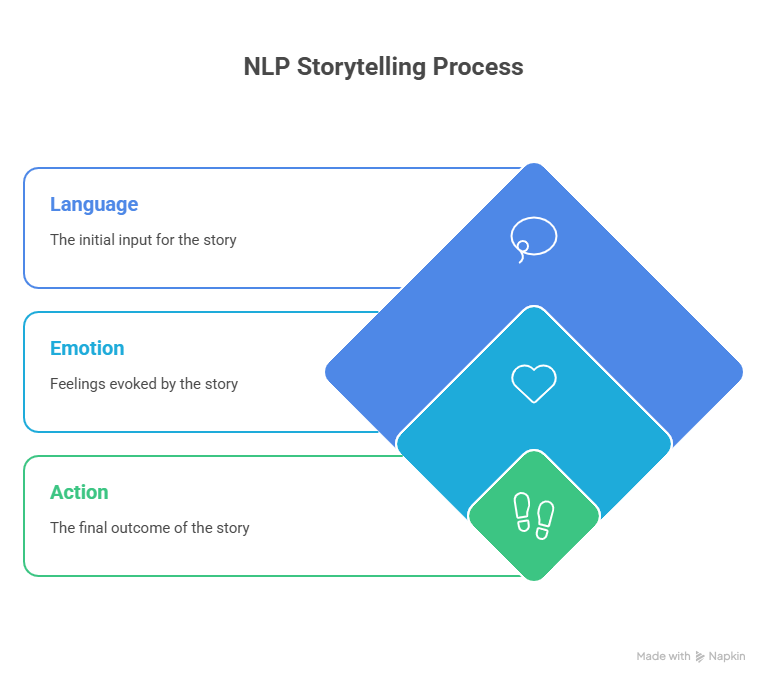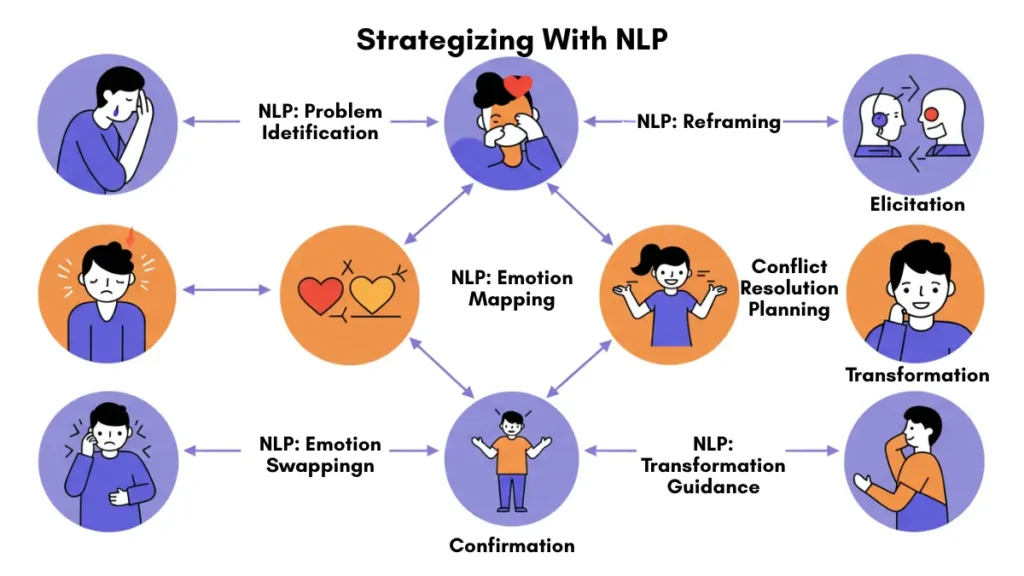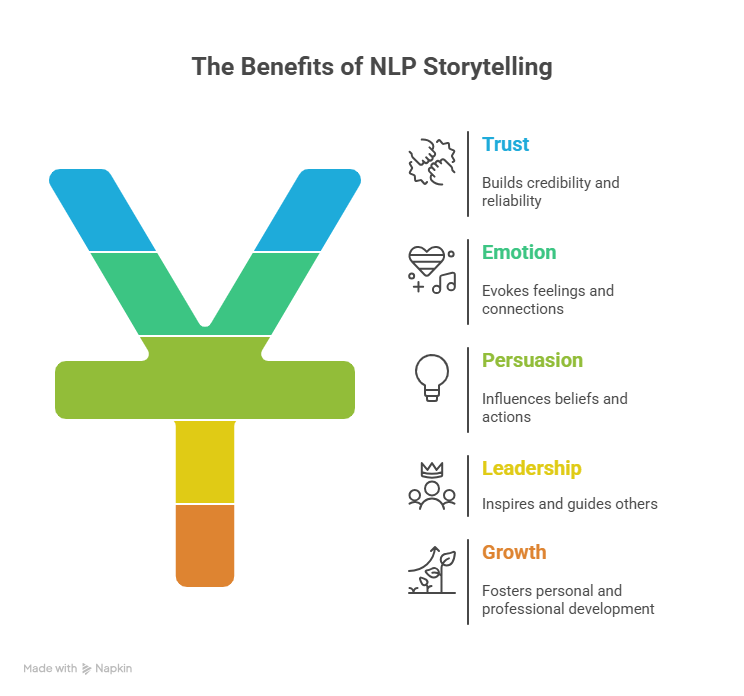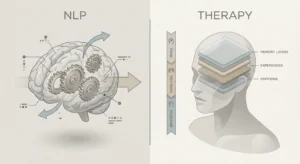Storytelling is one of the most powerful communication tools in business. When combined with Neuro-Linguistic Programming (NLP), it boosts persuasion, emotional connection, and audience engagement. This method helps leaders, marketers, and entrepreneurs influence authentically while strengthening trust and relationships.
In today’s fast-paced world, businesses are competing not just for sales, but for attention and emotional connection. Facts alone don’t drive decisions; stories do. Whether you’re presenting to investors, leading a team, or marketing your services, storytelling turns complex ideas into relatable experiences.
Neuro-Linguistic Programming (NLP) brings structure to this art. It’s the science of understanding how people think, feel, and communicate. When integrated with storytelling, NLP makes messages more impactful, helping brands connect with their audience at both emotional and psychological levels.
Key Takeaways
- NLP-powered storytelling boosts business communication through emotion and structure.
- It aligns words, tone, and behavior for maximum persuasive impact.
- Authenticity, empathy, and sensory detail are essential for success.
- Businesses using NLP storytelling see higher conversions, loyalty, and leadership effectiveness.
The Psychology Behind Storytelling in Business
Stories engage both the emotional and rational parts of the brain. Research shows they are up to 22 times more memorable than facts alone. That’s because stories release oxytocin, the hormone that fosters empathy and trust, essential traits in business relationships.
When your business communication includes authentic stories of clients, company vision, or personal growth, you create credibility and connection that no sales pitch can match.
What Is NLP and How Does It Work
Neuro-Linguistic Programming (NLP) studies the relationship between thoughts, language, and behavioral patterns. It helps communicators use language intentionally to inspire desired outcomes.

Core Principles of NLP:
- Sensory Language: Speak to the five senses (see, hear, feel, taste, smell).
- Anchoring: Link positive emotions to your brand story.
- Reframing: Shift perception to turn problems into opportunities.
- Rapport Building: Create connections through matching communication styles.
Why Storytelling Boosts Business with NLP
Storytelling has always been at the heart of powerful business communication. When combined with Neuro-Linguistic Programming (NLP), it becomes a science-backed strategy to influence, engage, and inspire action. By blending emotional storytelling with NLP techniques, businesses can connect with their audience’s subconscious mind, building trust, loyalty, and measurable growth.
NLP Helps You Speak to the Subconscious Mind
Neuro-Linguistic Programming (NLP) gives you the tools to communicate beyond surface-level language. It helps you tap into the subconscious mind, where emotions and decisions truly form. In business storytelling, this means crafting messages that resonate deeply using tone, words, and imagery that align with how people naturally process experiences. Instead of presenting data alone, NLP storytelling transforms information into emotionally charged narratives that inspire trust and action.
Emotion-Driven Narratives Build Deeper Trust
Facts inform, but emotions persuade. NLP storytelling harnesses emotional triggers through tools like anchoring and sensory-rich language words that make your audience see, feel, and hear your message. This approach builds emotional memory, making your brand or message more relatable and unforgettable. When customers or teams feel understood and emotionally connected, they develop stronger loyalty and engagement.
NLP Adds Structure and Flow

Storytelling becomes far more powerful when guided by NLP’s structured techniques. NLP provides frameworks to build narratives that follow a psychological journey from conflict to resolution, and challenge to transformation. This helps business leaders craft presentations, brand stories, and sales pitches that feel natural yet persuasive. By pacing stories effectively and ending with an emotional transformation, you create an impact that lingers long after the story ends.
Consistency Between Words, Tone and Body Language

True influence comes when your communication is congruent. NLP emphasizes rapport-building and mirroring, ensuring your tone, gestures, and words are perfectly aligned. When your body language reinforces your message, audiences sense authenticity and confidence, two traits essential for business success. Whether in client meetings or marketing videos, this alignment strengthens trust and credibility.
Measurable Business Impact
The integration of NLP storytelling goes beyond soft skills; it delivers tangible results. Companies using NLP-driven storytelling often see improved sales conversion, better internal communication, and stronger leadership influence. By fostering emotional alignment with audiences, businesses create genuine human connections that drive retention, motivation, and brand loyalty. NLP storytelling doesn’t just tell stories; it transforms them into measurable growth tools.
Benefits of Using NLP Storytelling in Business
Integrating NLP (Neuro-Linguistic Programming) with storytelling can transform the way businesses communicate, inspire, and grow. Here’s how it creates lasting impact:

- Strengthens Emotional Connection with Audiences:
NLP storytelling taps into how people think, feel, and respond emotionally. By using sensory language and emotional cues, businesses can connect deeply with their audience’s subconscious mind, making messages more relatable and memorable. - Builds Authenticity and Long-Term Trust:
In an era of information overload, authenticity sets brands apart. NLP encourages genuine communication by aligning your words, tone, and body language, which builds credibility and long-term loyalty among clients or employees. - Enhances Clarity and Persuasion in Sales and Marketing:
NLP helps structure messages that appeal to both logic and emotion. Marketers can use it to craft narratives that simplify complex ideas, address objections subconsciously, and inspire buying decisions without sounding forceful. - Improves Leadership Influence and Motivation:
For business leaders, NLP storytelling is a tool to inspire action. It helps them communicate vision, motivate teams, and handle resistance more effectively by connecting emotionally with employees’ core values and motivations. - Drives Measurable Business Growth Through Engagement:
Brands using NLP-infused storytelling often see higher engagement rates, stronger client relationships, and improved conversion metrics. Emotional connection translates into brand advocacy, referrals, and long-term growth.
Practical Ways to Apply NLP Storytelling
Applying NLP storytelling in business isn’t just about telling better stories; it’s about communicating with purpose and emotional precision. When used effectively, it helps brands, leaders, and teams connect with people on a deeper level by aligning words, tone, and emotion. Here are a few practical ways to bring NLP storytelling into your business strategy for greater influence and engagement.
- Use Sensory-Rich Language: Describe experiences using vivid sensory words (sight, sound, touch, emotion) to immerse your audience and make your message unforgettable.
- Incorporate Metaphors and Reframing:
Use metaphors to simplify ideas and reframing techniques to turn challenges into opportunities, ideal for leadership talks and motivational speeches. - Train Teams in NLP Communication:
Equip your teams with NLP-based communication tools to improve empathy, collaboration, and emotional intelligence in the workplace. - Create Emotional Brand Anchors:
Associate your brand with positive emotional triggers like confidence, joy, or trust so customers naturally connect those feelings with your products or services. - Showcase Customer Success Stories:
Tell real customer stories using NLP’s emotional sequencing: start with a challenge, show transformation, and end with success to evoke inspiration and relatability.
FAQs
1. What is NLP in storytelling?
NLP helps shape stories that connect with the subconscious mind using emotional and sensory cues, making them more persuasive.
2. Why is storytelling important in business?
It builds emotional bonds, increases trust, and makes complex ideas easier to understand and remember.
3. How does NLP enhance business communication?
It aligns language and behavior with audience psychology for more effective and influential communication.
4. Can NLP storytelling improve sales?
Yes, by appealing to emotions and motivations, it enhances message resonance and conversion rates.
5. Is NLP ethical in business storytelling?
When used authentically and respectfully, NLP is a powerful and ethical communication tool.
Final Thoughts
In a world filled with noise, stories create a signal. By combining the art of storytelling with the science of NLP, you create business communication that not only informs but transforms.
When done with authenticity and purpose, NLP storytelling becomes your most powerful leadership and marketing asset, helping your audience feel seen, understood, and inspired to take action.





